24.03.2021
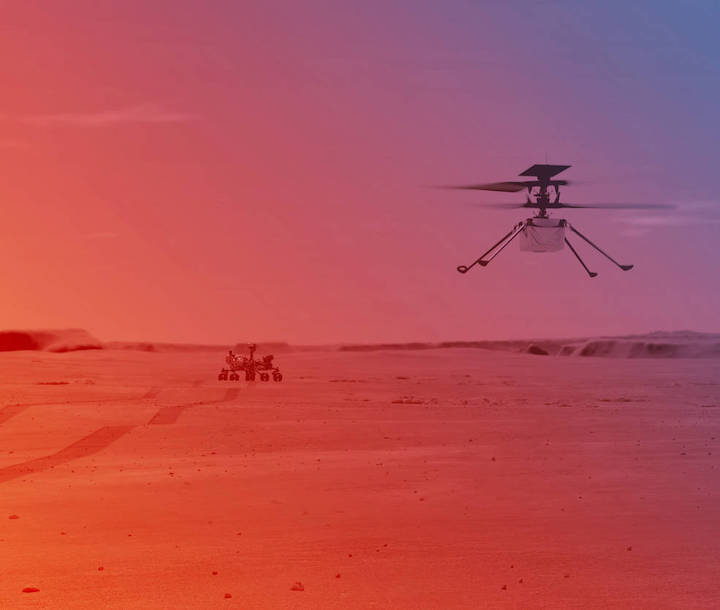
NASA is targeting no earlier than April 8 for the Ingenuity Mars Helicopter to make the first attempt at powered, controlled flight of an aircraft on another planet. Before the 4-pound (1.8-kilogram) rotorcraft can attempt its first flight, however, both it and its team must meet a series of daunting milestones.
Ingenuity remains attached to the belly of NASA’s Perseverance rover, which touched down on Mars Feb. 18. On March 21, the rover deployed the guitar case-shaped graphite composite debris shield that protected Ingenuity during landing. The rover currently is in transit to the “airfield” where Ingenuity will attempt to fly. Once deployed, Ingenuity will have 30 Martian days, or sols, (31 Earth days) to conduct its test flight campaign.
“When NASA’s Sojourner rover landed on Mars in 1997, it proved that roving the Red Planet was possible and completely redefined our approach to how we explore Mars. Similarly, we want to learn about the potential Ingenuity has for the future of science research,” said Lori Glaze, director of the Planetary Science Division at NASA Headquarters. “Aptly named, Ingenuity is a technology demonstration that aims to be the first powered flight on another world and, if successful, could further expand our horizons and broaden the scope of what is possible with Mars exploration.”
Flying in a controlled manner on Mars is far more difficult than flying on Earth. The Red Planet has significant gravity (about one-third that of Earth’s) but its atmosphere is just 1% as dense as Earth’s at the surface. During Martian daytime, the planet’s surface receives only about half the amount of solar energy that reaches Earth during its daytime, and nighttime temperatures can drop as low as minus 130 degrees Fahrenheit (minus 90 degrees Celsius), which can freeze and crack unprotected electrical components.
To fit within the available accommodations provided by the Perseverance rover, the Ingenuity helicopter must be small. To fly in the Mars environment, it must be lightweight. To survive the frigid Martian nights, it must have enough energy to power internal heaters. The system – from the performance of its rotors in rarified air to its solar panels, electrical heaters, and other components – has been tested and retested in the vacuum chambers and test labs of NASA’s Jet Propulsion Laboratory in Southern California.
“Every step we have taken since this journey began six years ago has been uncharted territory in the history of aircraft,” said Bob Balaram, Mars Helicopter chief engineer at JPL. “And while getting deployed to the surface will be a big challenge, surviving that first night on Mars alone, without the rover protecting it and keeping it powered, will be an even bigger one.”
Deploying the Helicopter
Before Ingenuity takes its first flight on Mars, it must be squarely in the middle of its airfield – a 33-by-33-foot (10-by-10-meter) patch of Martian real estate chosen for its flatness and lack of obstructions. Once the helicopter and rover teams confirm that Perseverance is situated exactly where they want it to be inside the airfield, the elaborate process to deploy the helicopter on the surface of Mars begins.
“As with everything with the helicopter, this type of deployment has never been done before,” said Farah Alibay, Mars Helicopter integration lead for the Perseverance rover. “Once we start the deployment there is no turning back. All activities are closely coordinated, irreversible, and dependent on each other. If there is even a hint that something isn’t going as expected, we may decide to hold off for a sol or more until we have a better idea what is going on.”
The helicopter deployment process will take about six sols (six days, four hours on Earth). On the first sol, the team on Earth will activate a bolt-breaking device, releasing a locking mechanism that helped hold the helicopter firmly against the rover’s belly during launch and Mars landing. The following sol, they will fire a cable-cutting pyrotechnic device, enabling the mechanized arm that holds Ingenuity to begin rotating the helicopter out of its horizontal position. This is also when the rotorcraft will extend two of its four landing legs.
During the third sol of the deployment sequence, a small electric motor will finish rotating Ingenuity until it latches, bringing the helicopter completely vertical. During the fourth sol, the final two landing legs will snap into position. On each of those four sols, the Wide Angle Topographic Sensor for Operations and eNgineering (WATSON) imager will take confirmation shots of Ingenuity as it incrementally unfolds into its flight configuration. In its final position, the helicopter will hang suspended at about 5 inches (13 centimeters) over the Martian surface. At that point, only a single bolt and a couple dozen tiny electrical contacts will connect the helicopter to Perseverance. On the fifth sol of deployment, the team will use the final opportunity to utilize Perseverance as a power source and charge Ingenuity’s six battery cells.
“Once we cut the cord with Perseverance and drop those final five inches to the surface, we want to have our big friend drive away as quickly as possible so we can get the Sun’s rays on our solar panel and begin recharging our batteries,” said Balaram.
On the sixth and final scheduled sol of this deployment phase, the team will need to confirm three things: that Ingenuity’s four legs are firmly on the surface of Jezero Crater, that the rover did, indeed, drive about 16 feet (about 5 meters) away, and that both helicopter and rover are communicating via their onboard radios. This milestone also initiates the 30-sol clock during which time all preflight checks and flight tests must take place.
“Ingenuity is an experimental engineering flight test – we want to see if we can fly at Mars,” said MiMi Aung, project manager for Ingenuity Mars Helicopter at JPL. “There are no science instruments onboard and no goals to obtain scientific information. We are confident that all the engineering data we want to obtain both on the surface of Mars and aloft can be done within this 30-sol window.”
As with deployment, the helicopter and rover teams will approach the upcoming flight test methodically. If the team misses or has questions about an important preflight milestone, they may take one or more sols to better understand the issue. If the helicopter survives the first night of the sequence period on the surface of Mars, however, the team will spend the next several sols doing everything possible to ensure a successful flight, including wiggling the rotor blades and verifying the performance of the inertial measurement unit, as well as testing the entire rotor system during a spin-up to 2,537 rpm (while Ingenuity’s landing gear remain firmly on the surface).
The First Flight Test on Mars
Once the team is ready to attempt the first flight, Perseverance will receive and relay to Ingenuity the final flight instructions from JPL mission controllers. Several factors will determine the precise time for the flight, including modeling of local wind patterns plus measurements taken by the Mars Environmental Dynamics Analyzer (MEDA) aboard Perseverance. Ingenuity will run its rotors to 2,537 rpm and, if all final self-checks look good, lift off. After climbing at a rate of about 3 feet per second (1 meter per second), the helicopter will hover at 10 feet (3 meters) above the surface for up to 30 seconds. Then, the Mars Helicopter will descend and touch back down on the Martian surface.
Several hours after the first flight has occurred, Perseverance will downlink Ingenuity’s first set of engineering data and, possibly, images and video from the rover’s Navigation Cameras and Mastcam-Z. From the data downlinked that first evening after the flight, the Mars Helicopter team expect to be able to determine if their first attempt to fly at Mars was a success.
On the following sol, all the remaining engineering data collected during the flight, as well as some low-resolution black-and-white imagery from the helicopter’s own Navigation Camera, could be downlinked to JPL. The third sol of this phase, the two images taken by the helicopter’s high-resolution color camera should arrive. The Mars Helicopter team will use all information available to determine when and how to move forward with their next test.
“Mars is hard,” said Aung. “Our plan is to work whatever the Red Planet throws at us the very same way we handled every challenge we’ve faced over the past six years – together, with tenacity and a lot of hard work, and a little Ingenuity.”
A Piece of History
While Ingenuity will attempt the first powered, controlled flight on another planet, the first powered, controlled flight on Earth took place Dec. 17, 1903, on the windswept dunes of Kill Devil Hill, near Kitty Hawk, North Carolina. Orville and Wilbur Wright covered 120 feet in 12 seconds during the first flight. The Wright brothers made four flights that day, each longer than the previous.
A small amount of the material that covered one of the wings of the Wright brothers’ aircraft, known as the Flyer, during the first flight is now aboard Ingenuity. An insulative tape was used to wrap the small swatch of fabric around a cable located underneath the helicopter’s solar panel. The Wrights used the same type of material – an unbleached muslin called “Pride of the West” – to cover their glider and aircraft wings beginning in 1901. The Apollo 11 crew flew a different piece of the material, along with a small splinter of wood from the Wright Flyer, to the Moon and back during their iconic mission in July 1969.
More About Ingenuity
The Ingenuity Mars Helicopter was built by JPL, which also manages the technology demonstration for NASA Headquarters. It is supported by NASA’s Science Mission Directorate, the NASA Aeronautics Research Mission Directorate, and the NASA Space Technology Mission Directorate. NASA’s Ames Research Center and Langley Research Center provided significant flight performance analysis and technical assistance.
At NASA Headquarters, Dave Lavery is the program executive for the Ingenuity Mars Helicopter. At JPL, MiMi Aung is the project manager and J. (Bob) Balaram is chief engineer.
Bring the excitement of Ingenuity into classrooms and homes through NASA’s Office of STEM Engagement toolkit. Educators, students, and families can follow along the mission by building a paper helicopter or coding an Ingenuity video game.
Quelle: NASA
----
Update: 26.03.2021
.
Perseverance has found a place to deploy Ingenuity
NASA’s rover has found its Kitty Hawk.
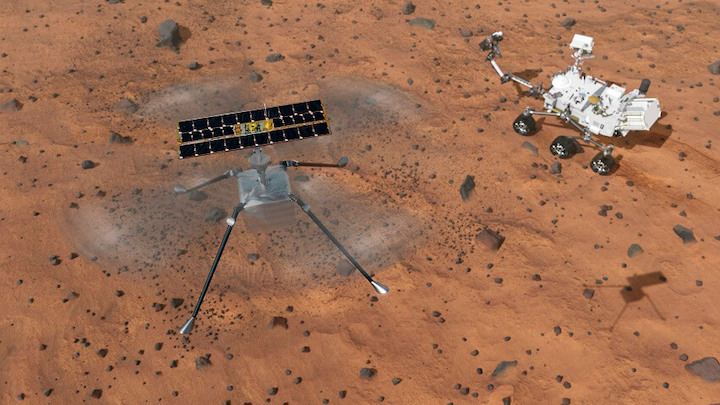
Artwork of NASA's Mars 2020 mission. The mission consists of a 3-metre-long rover called Perseverance, and a smaller 'rotorcraft' called Ingenuity. Credit: Credit: Mark Garlick /Science Photo Library / Getty Images.
Kitty Hawk is the place where, in 1903, the Wright brothers found a suitable field of level ground from which to make the world’s first airplane flight.
Perseverance’s patch of level ground is on Mars and is where, perhaps in the next three weeks, it will deploy the world’s first extraterrestrial helicopter.
Named Ingenuity, the helicopter is 1.8 kilograms of high-tech rotors, spindly legs, and solar panels, currently tucked safely in the belly of the Perseverance rover.
Although it carries a camera, it is not a science experiment. Rather, it’s a proof of concept, designed to pave the way to bigger and better things, much as NASA’s 1997 Sojourner rover – which weighed only 11.5 kg and traveled only 100 metres – led to the Spirit, Opportunity, and Curiosity missions, and now to Perseverance itself.
“It’s the next in experimental aircraft, dating all the way back to the Wright brothers,” says Bob Balaram of NASA’s Jet Propulsion Laboratory in California, who is the helicopter’s chief engineer. In honour of that, he adds, it even carries a tiny piece of fabric from the Wright brother’s original aircraft.
It has, of course, been extensively tested on Earth, including in a 25-foot (8 metre) chamber designed to simulate the thin Martian atmosphere.
But flying in the lab is one thing. Flying on Mars is another. The biggest challenge, says Balaram, is that the Martian atmosphere has its own dynamics, complete with wind gusts, dust, and other unpredictable events. (Not to mention that the gravity on Mars is only 38% that on Earth.)
As much of that as possible has been tested, Balaram says, “but there’s nothing that beats being in the environment of Mars”.
From the moment Perseverance touched down on 18 February, one of the flight crew’s top priorities was finding a suitable “airfield” for the helicopter.
But it turned out to be an easy quest, says Håvard Grip, Ingenuity’s chief pilot.
After looking through satellite images and photos taken by the rover during its descent, he says, “we began to realise that we might just have a truly great airfield right in front of our noses”.
The rover’s search for a safe landing spot on its descent had put it in the perfect place for Ingenuity’s test flight.
Not that the helicopter is set to fly tomorrow. First, the rover needs to drive to the middle of the airfield, conduct about 10 days of tests, carefully lower the helicopter to the ground, and then, without wasting too much time checking things out, back away from it (without running over it in the process), thereby allowing the helicopter’s solar panels to see the light.
“It needs sun and can only survive one Martian night without that,” says Farah Alibay, the systems engineer in charge of the process.
There will then be another week or so of testing, at which point the rover will drive to a low mound from which to observe.
Only then will the helicopter attempt to take off.
That initial flight, says Grip, won’t be anything like the loops and rolls conducted by drone pilots in your local park. Rather, the helicopter will rise 3m above the surface, hover for 30 seconds, rotate while hovering, and descend.
“We will declare complete mission success if we do this,” Grip says.
If that works, however, the helicopter has more tricks up its sleeve. Next up would be a short back-and-forth traverse (all within the safety of the airstrip zone), and if that works, it might even go on a more adventurous expedition, though at the moment, everything is focused on the first two flights.
When will all of this occur? Nobody’s making promises, but Balaram says it might come as soon as 8 April…or even a few days earlier.
“April feels to me like the month of Ingenuity,” says Bobby Braun, JPL’s director for planetary science.
Quelle: COSMOS
----
Update: 28.03.2021
.
NASA primed for historic flight of experimental Mars helicopter
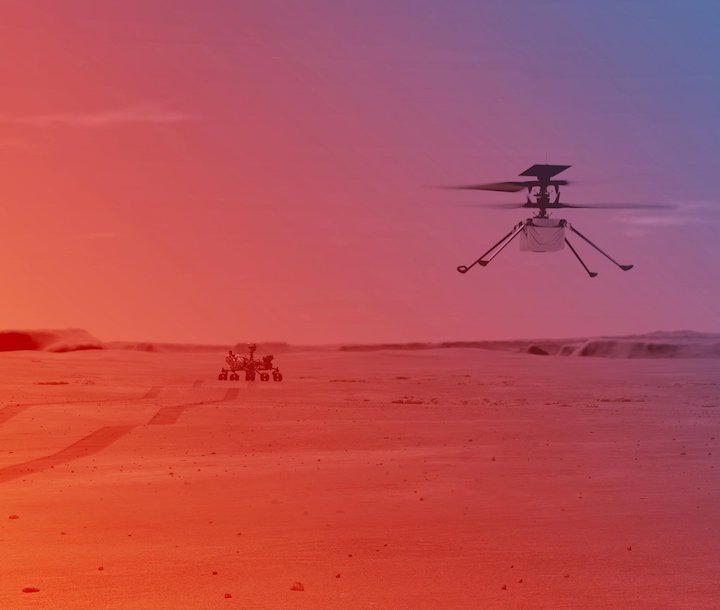
NASA’s Perseverance rover will soon release a small rotorcraft onto the surface of Mars and drive a safe distance away to observe a series of historic test flights in the ultra-thin Martian atmosphere, which could begin around April 8, officials said this week.
The Mars Helicopter, named Ingenuity, has been stowed underneath the deck of the Perseverance rover for nearly one year. Ground crews at the Kennedy Space Center installed the 4-pound (1.8-kilogram) rotorcraft onto the belly of the rover April 6, 2020, during preparations for Perseverance’s launch last July.
Controllers at NASA’s Jet Propulsion Laboratory are now preparing to send commands to release the Ingenuity helicopter. The rover released a debris cover March 21 to reveal the helicopter. The carbon-fiber shield protected Ingenuity from rocks and dust kicked up during the rover’s landing on Mars on Feb. 18.
The rotorcraft was a relatively late addition to Perseverance’s mission. NASA approved the helicopter technology demonstration to fly to Mars with the Perseverance rover in 2018, just two years before launch.
NASA spent $80 million developing and building the helicopter, which will stand about 1.6 feet (0.5 meters) tall and has counter-rotating rotors that will span about 4 feet (1.2 meters) tip-to-tip. Another $5 million is devoted to operating the helicopter during a 31-day test campaign, which officially begins when Perseverance releases Ingenuity in the coming days.
Ingenuity’s test flight is scheduled for around April 8, but that date could change as the helicopter goes through its deployment and testing milestones, according to Bob Balaram, helicopoter’s chief engineer at JPL.
The helicopter’s first hop is designed to reach an altitude of about 10 feet, or 3 meters. Ingenuity will hover in place for about 30 seconds, then make a turn while it’s hovering before descending back to the surface of Mars.
“The first flight is special,” said Håvard Grip, Ingenuity’s chief pilot at JPL, during a press conference Tuesday. “It’s by far the most important flight that we plan to do. It will be the first powered flight by an aircraft on another planet.”
Bobby Braun, director of planetary science at JPL, said the helicopter and its support team back on Earth will attempt to produce a “Wright brothers’ moment” on another world.
Recognizing Ingenuity’s flight as another aviation first, NASA installed a postage stamp-size piece of fabric from the Wright brothers’ first aircraft, known as the Flyer, onto the Mars helicopter. The fabric covered one of the aircraft’s wings during its first flight at Kitty Hawk, North Carolina, on Dec. 17, 1903.
Another piece of fabric and a fragment of spruce wood from the Wright Flyer flew to the moon on the Apollo 11 mission in 1969. While the Wright brothers used fabric and wood for their aircraft, Ingenuity is made of carbon-fiber skins and “exotic metals,” Balaram said.
“This is, in effect, an aircraft that also happens to be a spacecraft,” Balaram said. “It has survived launch. It has survived the journey through space, the vacuum and radiation, it has survived the entry, descent and landing onto the surface on the bottom of the Perseverance rover, and it has survived all the challenges and design issues that are necessary for a spacecraft.
“But most of all I think of Ingenuity also as an experimental aircraft,” he said.
The surface pressure of the Martian atmosphere is about 1% that of Earth’s, meaning Ingenuity’s rotors will have to generate extra lift to allow the helicopter to take off. The Mars helicopter’s rotors will spin about five-to-ten times faster than a typical helicopter flying in Earth’s atmosphere.
Lori Glaze, head of NASA’s planetary science division, described the Ingenuity helicopter as a “high-risk, high-reward” experiment that could pave the way for future aerial vehicles to explore Mars and other planets.
Before it can attempt to make history, the helicopter will through a series of deployment and checkout steps. It will take about six days to fully release the rotorcraft from the rover, first releasing a launch lock that kept Ingenuity firmly attached to the rover during the trip to Mars.
Then a pyrotechnic device will cut a table to allow Ingenuity to begin rotating out of its horizontal position, and the helicopter will extend two of its four landing legs. By the third day, an electric motor will fully rotate Ingenuity into a vertical orientation underneath the rover, and the other two landing legs will unfurl into position on the fourth day of the helicopter’s deployment sequence, according to NASA.
At that point, the helicopter will remain attached to the rover by a single bolt and a couple of tiny electrical connectors, NASA said.

NASA says a wide angle camera at the end of the rover’s robotic arm will take pictures of Ingenuity throughout the sequence to confirm everything looks good.
On the day before Perseverance releases the helicopter, the Ingenuity team at JPL will fully charge the rotorcraft’s six battery cells using electricity from the rover’s plutonium power source. Then the rover will sever its connection to the helicopter to drop about 5 inches (13 centimeters) down to the Martian surface.
“Then there will the deposition of the helicopter on the surface, and then there will be that first exposure to sunlight where we have to charge the batteries by ourselves,” Balaram said. “We are no longer part of the Perseverance rover and connected safely and we are completely on our own, fully autonomous, waiting to receive commands.
Once Ingenuity is on the ground, the Perseverance begin driving away from the helicopter. Its destination will be an observation point at least 200 feet, or 60 meters, away from Ingenuity’s flight zone, which itself is about the length of a football field. The flight zone includes an airfield, a 33-by-33-foot (10-by-10-meter) area where the helicopter will take off and land.
Ground teams selected the location for the airfield with the help of imagery from Perseverance’s cameras, which surveyed the landscape at its landing site at Jezero Crater over the last month. The region chosen for the test flights is flat, with few rocks or obstacles that could pose a threat to the helicopter.
There will be a bit of drama after the rover releases the helicopter onto the surface.
Ingenuity’s batteries can power the helicopter and keep its internal electronics warm for about 25 hours before they need recharged. The rover will be shading Ingenuity’s solar panels after it releases the aircraft, so it will have to drive away within a day to allow sunlight to illuminate the helicopter, according to Farah Alibay, an engineer who oversees Perseverance’s integration with the Ingenuity helicopter.

“We will go through a number of days of commissioning, approximately a week, where we test out sensors, we test out solar mechanisms, we test the motors to make sure they spin right, and we will be very methodical and even driven as this engineering experiment unfolds,” Balaram said. “And then we will be at a point where we will undertake our first flight and then we will progressively undertake more aggressive flights once we understand and analyze all the behaviors on that first flight.”
Ingenuity’s counter-rotating rotors will spin up to 2,537 rpm — more than 40 times per second — while the helicopter remains on the ground, a final test before engineers commit the aircraft to flight.
“Our current best estimate of when the (first) flight could happen is no earlier than about April 8, but things are fluid,” Balaram said. “We are very event and experiment driven, so that could be changed by a few days in either direction, but the best guess that we have right now is about April 8.”
Mars is currently about 159 million miles, or 259 million kilometers, from Earth. It takes communications signals about 14 minutes make a one-way trip between the planets, eliminating any chance for ground teams to fly Ingenuity in real-time.
Instead, engineers will uplink commands for each of the helicopter’s flights, and Ingenuity will autonomously take off and land, using a vision-based navigation system to help guide its flights.
Engineers tested the helicopter in a low-pressure chamber at JPL, which simulates the atmospheric conditions on Mars.
Before committing the helicopter to flight, engineers will assess wind conditions and other weather parameters, such as atmospheric density, to maximize the chances of success. Controllers at JPL can adjust the rotor speed to best match the atmospheric conditions on the day of each flight.
“I think the biggest challenge will be that we are are flying in the atmosphere of Mars, which has its own dynamics, its own winds, with gusts and so forth,” Balaram said. “These are things which we tested with wind tunnels in our chamber. We have some confidence that everything will be good, but there’s nothing that beats actually being in the real environment of Mars to see how well the … aerodynamics actually work out.”
Balaram said there are also challenges related to surviving the cold Martian nights, when temperatures dip well below zero.
“It’s difficult to keep a small system warm through the night. So just to see how well that thermal system protects us through the night, how well does the solar panel work?” he said. “There are a number of engineering aspects before you even get to the flight. But when it comes to the actual flying, it’s really the winds and the dynamics of how that all interacts with the helicopter that will be most interesting for us to learn.”
Assuming the first flight goes well, Ingenuity could fly up to four more times, reaching a higher altitude of about 16 feet (5 meters) and traversing downrange along the pre-selected flight zone, before returning to its “helipad” for landing.
The 16-foot limit for Ingenuity’s flights is largely driven by the performance limitations of a laser rangefinder on-board that measures the helicopter’s distance to the ground, according to Grip.
“We’re focusing on demonstrating basic capability to hover and then traversing and going longer distances, where we go down the flight zone and back again,” Grip said. “And then if we get past those, we will assess did we meet all tho objectives during those flights, do we want to back and retry some of those things, or if everything goes really well, then we might try to stretch our capabilities.”
NASA has set aside just one month for Ingenuity’s test flights because the $2.4 billion Perseverance mission needs to get moving in pursuit of its own higher-priority scientific objectives. The rover is designed to collect rock samples for return to Earth by a future mission set to arrive at Mars in the late 2020s.
Scientists back on Earth will analyze the specimens and search for signs of ancient Martian life.
“Ingenuity is a limited time project,” Glaze said. “It will have 31 Earth days to attempt to be the first helicopter to fly on another planet. It isn’t intended to collect science, but because its mission is so focused, it is, at its core, innovative.”
NASA’s first Mars rover, named Sojourner, landed on the Red Planet in 1997 and proved the usefulness of surface mobility in exploring other worlds.
“Sojourner redefined what we thought was possible on the surface of Mars and completely transformed our approach to how we explore it,” Glaze said. “That small rover enabled all the missions to follow, and now Perseverance — the size of a small car — is able to carry other technology demonstrations, like Ingenuity, which will further expand our horizons.”
Future rotorcraft could be dispatched to other planets with more sophisticated scientific instruments.
NASA has selected a robotic mission named Dragonfly to explore Saturn’s largest moon Titan. But Titan has a much thicker atmosphere than Mars, which eases the difficulty of rotor-driven flight.
“If we can scout and scientifically survey Mars from the air with a thin atmosphere, we can certainly do the same in a number of other destinations across the solar system, like Titan or Venus,” Braun said.
Airborne drones could survey regions on other planets not reachable by rovers driving on the ground.
“The future of powered flight in space exploration is solid and strong,” Braun said.
Quelle: SN
----
Update: 30.03.2021
.
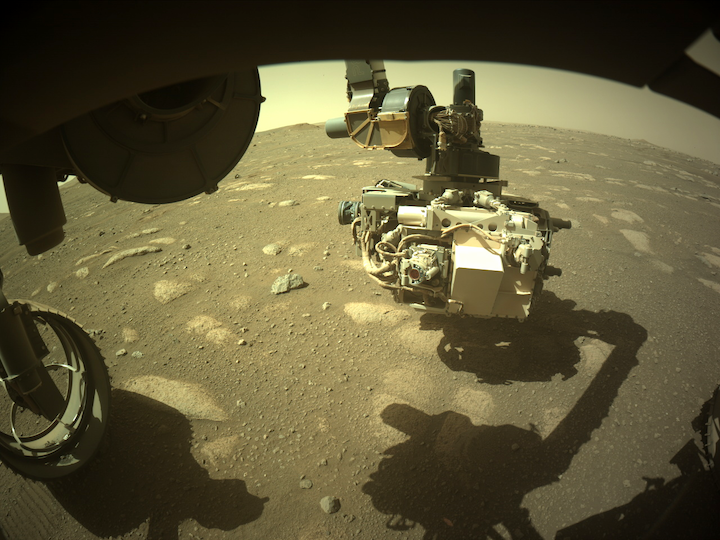
Mars Perseverance Sol 37: Front Left Hazard Avoidance Camera (Hazcam)
NASA's Mars Perseverance rover acquired this image of the area in front of it using its onboard Front Left Hazard Avoidance Camera A. This image was acquired on Mar. 28, 2021 (Sol 37) at the local mean solar time of 14:32:33.
Image Credit: NASA/JPL-Caltech
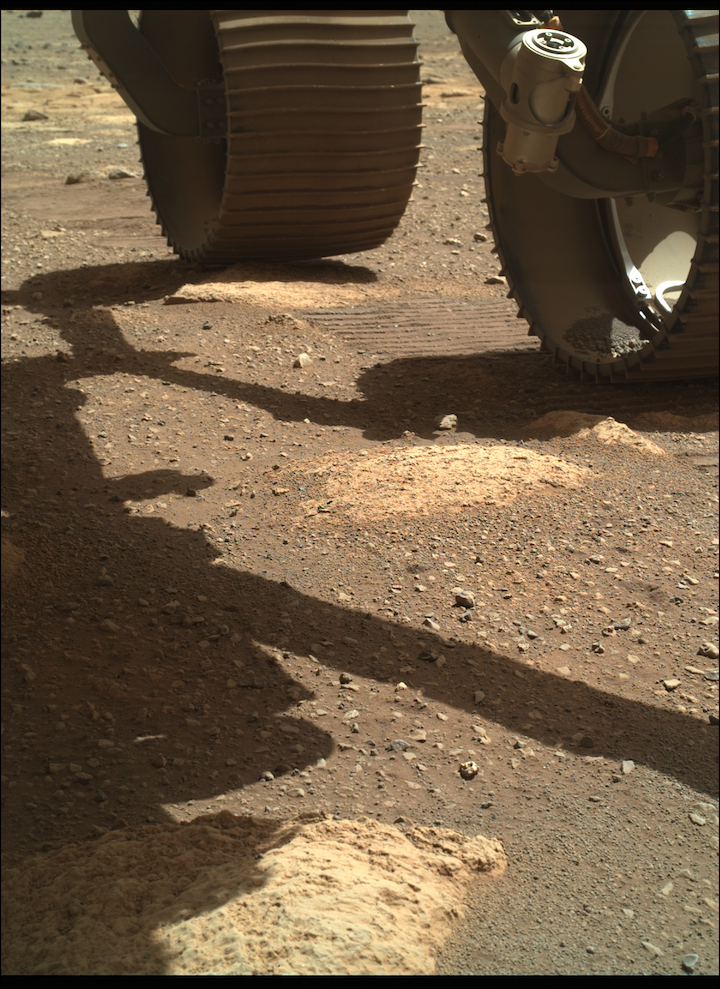
Mars Perseverance Sol 37: WATSON Camera
NASA's Mars Perseverance rover acquired this image using its SHERLOC WATSON camera, located on the turret at the end of the rover's robotic arm. This image was acquired on Mar. 28, 2021 (Sol 37) at the local mean solar time of 14:19:29.
Image Credit: NASA/JPL-Caltech
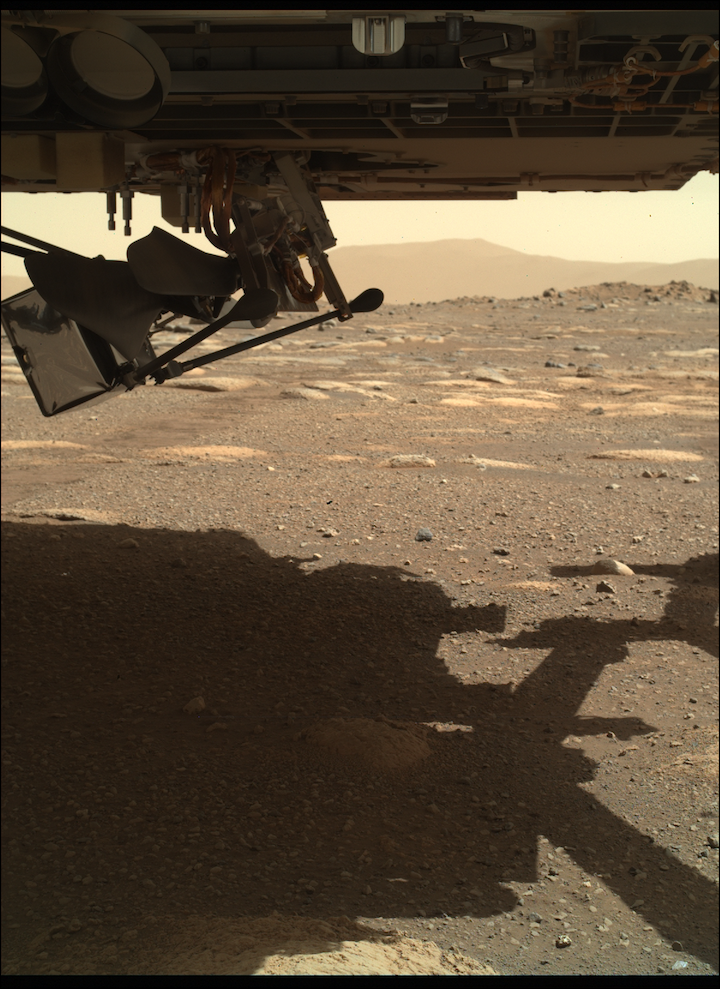
Mars Perseverance Sol 37: WATSON Camera
NASA's Mars Perseverance rover acquired this image using its SHERLOC WATSON camera, located on the turret at the end of the rover's robotic arm. This image was acquired on Mar. 28, 2021 (Sol 37) at the local mean solar time of 14:15:50.
Image Credit: NASA/JPL-Caltech
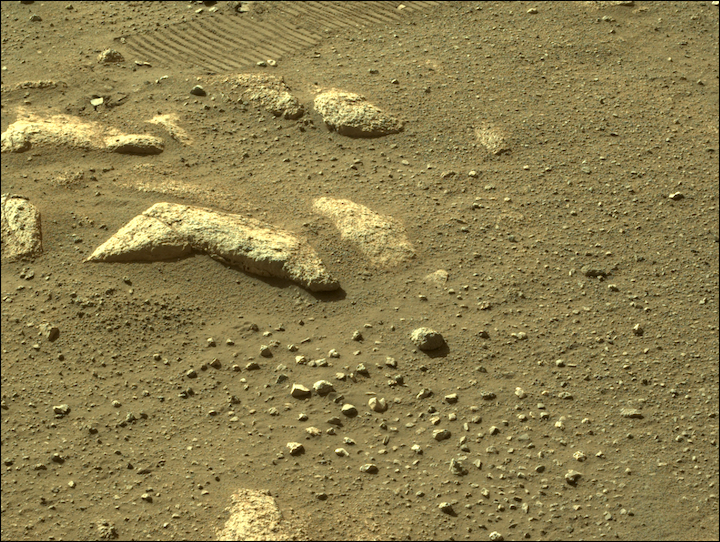
Mars Perseverance Sol 36: Right Navigation Camera (Navcam)
NASA's Mars Perseverance rover acquired this image using its onboard Right Navigation Camera (Navcam). The camera is located high on the rover's mast and aids in driving. This image was acquired on Mar. 28, 2021 (Sol 36) at the local mean solar time of 15:57:05.
Image Credit: NASA/JPL-Caltech
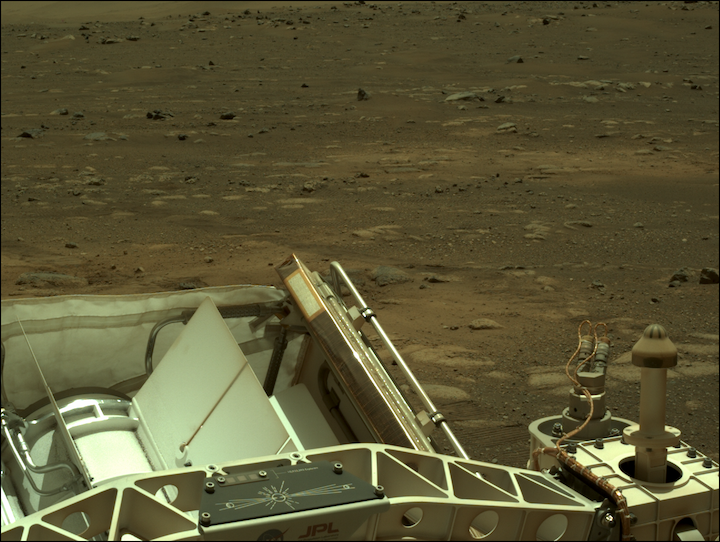
Mars Perseverance Sol 36: Left Navigation Camera (Navcam)
NASA's Mars Perseverance rover acquired this image using its onboard Left Navigation Camera (Navcam). The camera is located high on the rover's mast and aids in driving. This image was acquired on Mar. 27, 2021 (Sol 36) at the local mean solar time of 12:48:58.
Image Credit: NASA/JPL-Caltech
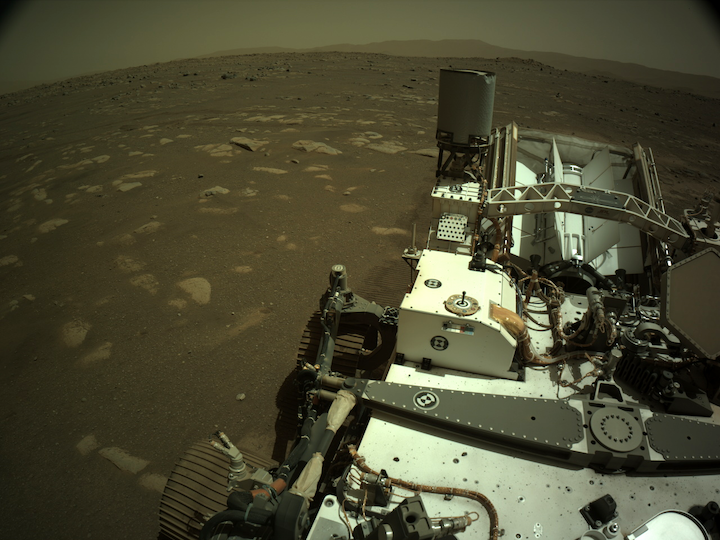
Mars Perseverance Sol 34: Right Navigation Camera (Navcam)
NASA's Mars Perseverance rover acquired this image using its onboard Right Navigation Camera (Navcam). The camera is located high on the rover's mast and aids in driving. This image was acquired on Mar. 26, 2021 (Sol 34) at the local mean solar time of 13:48:16.
Image Credit: NASA/JPL-Caltech
Quelle: NASA
